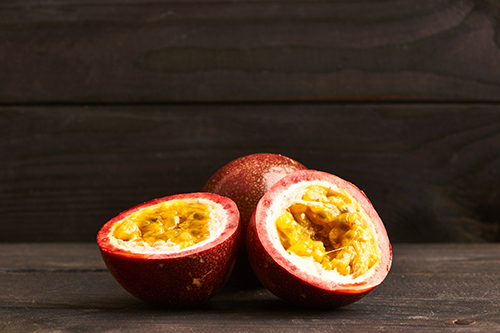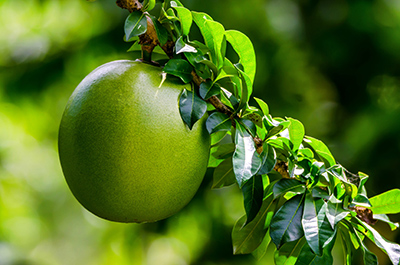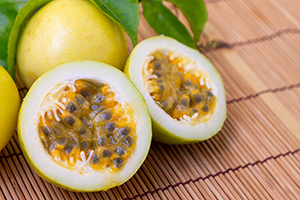Contents
Before we get into the many health benefits of passion fruit, let’s learn more about this fantastic fruit. Various species of the genus Passiflora provide edible fruit, all very aromatic with a tart flavor. The most widespread and utilized are those known as passion fruit, also called granadilla.

There are two primary varieties of passion fruit, which are different only in color and taste:
- Passiflora edulis, edulis variety: It is purple, and its pulp has a refreshing bittersweet taste.
- Passiflora edulis, flavicarpa variety: It is yellow with more acid and a less sweet flavor than the purple variety.
There is considerable confusion regarding each variety’s name in different parts of the world. Hence, the best way of describing them is to identify them by their color, purple or yellow. Although the composition, properties, and clinical indications described below refer specifically to the purple passion fruit (Passiflora edulis, edulis variety), they may be applied with minor differences to the yellow flavicarpa type.
Passion Fruit Nutritional Facts
The passion fruit pulp is gelatinous and very aromatic. The following nutrients stand out:
Sugars – Although they may not seem so because of their acid taste, they contain a considerable amount of sugar (13 percent), consisting of almost equal parts of glucose, fructose, and saccharose.
Proteins – With 2.2 percent, it is one of the most protein-rich fresh fruits.

1. Remove the pulp with a spoon.
2. Strain it to remove the seeds
3. Blend it to a homogenous consistency.
Iron – This is possibly the most iron fresh fruit (1.6 mg/100 grams), followed far back by the quince (0.7 mg), lemon (0.6 mg), raspberry (0.57 mg), and cherimoya (0.5 mg). Passion fruit surpasses an egg’s iron content (1.41 mg) and is close to meat (about 2 mg per 100 grams). Even though this iron is nonheme of vegetable origin and is absorbed with incredible difficulty compared to that of animal origin, the simultaneous presence of vitamin C in the passion fruit significantly enhances the absorption of this mineral.
Other minerals – Passion fruit is rich in magnesium, calcium, phosphorous, and potassium.
Vitamin—One hundred grams of passion fruit pulp provides 30 mg of vitamin C, half of the RDA (Recommended dietary allowance). It also contains provitamin A, vitamins B2, B6, and E, niacin, and folic acid.
Organic acids: Citric acid is predominant, but malic acid, lactic acid, malonic acid, and succinic acid are also present. The total of all acids is around 3.4 percent in the purple passion fruit and 4 percent in the yellow. Despite being rather acid-rich, passion fruit increases the blood’s alkalinity and metabolism in general.

Fiber—Passion fruit pulp is one of the wealthiest vegetable products in soluble fiber (pectin and mucilage). Compared to the insoluble fiber of grain bran, this fiber does not contain phytic acid and, as a result, does not interfere with iron absorption.
Aromatic non-nutritive substances – The pleasant aroma of the passion fruit is due to combining more than one hundred chemical substances. The slightly soothing effect of this fruit may be due to some of these aromatic substances, which are present in much higher concentrations in the passion flower’s leaves and blossoms (Passiflora incarnata L.) used as a medicinal plant.
Health Benefits

The pulp and the juice from the passion fruit are refreshing, stimulate the digestive function, and are mildly sedating, although their most crucial medicinal use is as an anti-anemic. Here are the main passion fruit therapeutic health benefits:
Iron deficiency anemia – Due to its very high iron content and the vitamin C that enables the absorption of this mineral, passion fruit is superb for anemics.
Constipation – The gelatinous pulp, and to a lesser degree, the juices made from it, exercise a mild laxative action and protect the lining of the intestine.
Nervousness and anxiety – Even though its sedating effect is much milder than the leaves and blossoms of the passion flower, it is appropriate for those wishing to relax the nervous system.
Scientific Facts

- Scientific name: Passiflora edulis Sims.
- Other names: Granadilla, Wild watermelon.
- French: Grenadille.
- Spanish: Fruta de la pasión, Pasionaria, Maracuyá.
- German: Passionsfrucht.
- Description: The fruit of different varieties of a climbing plant of the botanical family Passifloraceae is approximately the size and shape of an egg. Its color varies according to type, from purple to yellow. It has a gelatinous pulp full of black seeds.
- Environment: Passion fruit is raised in tropical regions, preferably at some altitude (400 to 2000 meters). Brazil is perhaps the largest producer, followed by Venezuela, Columbia, and Central America.
How to Prepare and Use Passion Fruit
- Fresh – The gelatinous pulp is eaten with a spoon, and the peel is used in a bowl. Separating the seeds from the pulp in the mouth is somewhat inconvenient.
- Juice – The pulp is filtered through a strainer and placed in a blender.
- As a complement that gives an exotic note to fruit dishes and various fresh or frozen desserts.
DISCLAIMER: All content on this website is presented solely for educational and informational objectives. Do not rely on the information provided as a replacement for advice, diagnosis, or treatment from a qualified medical expert. If you are pregnant, nursing, or have any preexisting medical concerns, talk to your doctor before using any herbal or natural medicines.
REFERENCES
- George D. Pamplona-Roger, M.D. “Encyclopedia of Foods and Their Healing Power.” George D. Pamplona-Roger, M.D. Encyclopedia of Foods and Their Healing Power. Trans. Annette Melgosa. Vol. 2. Chai Wan: Editorial Safeliz, 2005. 133, 134. Print.
- https://www.medicalnewstoday.com/articles/324383
- https://www.webmd.com/food-recipes/passion-fruit-health-benefits
Last update on 2025-06-04 / Affiliate links / Images from Amazon Product Advertising API




